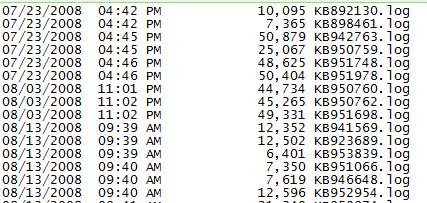Create A List Of All Installed Windows Hotfixes

Windows hotfixes usually solve errors and problems after they have been installed on a computer system. It happened in the past however that they did produce additional errors that could bring a computer system to a standstill. It is therefor handy to create a list of all installed Windows Hotfixes in the way that they have been installed on a computer system.
This can be achieved with a small batch file that will create a list of all installed Windows hotfixes, including the date and time that they have been installed on the system. The information is taken directly from the KBxxxxxx.log files that are created for each individual hotfix that is installed in Windows.
Those log files are located in the Windows directory and it would take some time to check them manually to build the list. Here is a screenshot of the output which is saved in a text document in the root directory of the main hard drive.
The code which has to be added in one line is the following:
dir %windir%\*.log /o:d | findstr /i /r /c:q......\.log /c:kb......\.log /c:q......uninst\.log /c:kb......uninst\.log > %systemdrive%\hotfixes.log
Some of you might prefer a direct download, just download the knowledgebase file and unpack it to the computer system. It contains the same code that is shown above.
You can alternatively display a list of installed Windows Updates right in the Programs and Features control panel applet, provided that it is Windows 7 or a newer version of Windows you are running.
To get there load the control panel, for instance via Start > Control Panel, and locate the uninstall a program link under Programs there. Locate View installed updates on the right of the next screen and click on it. Windows is now displaying the list of updates that you have installed on your system. There is no option to export the listing though.
Advertisement


















As all the other commands, it list only 20% of the updates, no more
If you’d prefer a searchable utility, try Nirsoft’s excellent WinUpdatesList.
It also has command line switches to generate reports in TXT,XML or HTML formats.
Plus, it’s freeware and stand-alone meaning no installation required. Another gem from NirSoft, IMHO.